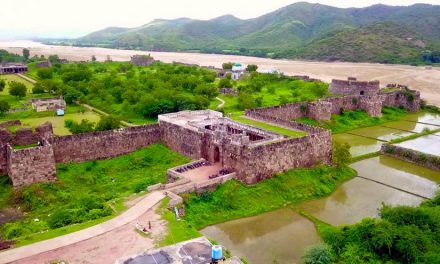There was a massive elephant blocking our way in that bamboo flanked dusty tract. We had stopped the vehicle and waited silently, too numb to respond to a tusker in the wild. But the guard accompanying us into the Chandaka Elephant Sanctuary was unruffled and he simply called out, `O Abhimanyu, make way’. The pachyderm paused and responded by moving into the forest. We watched it and were glad that we saw an elephant. There is another one called Ganesh in the periphery who is pet with the forest guards. Both these animals are tamed and trained by the forest officials to watch out for smugglers of wood and other forest produce.
This sanctuary is situated barely an half an hour’s journey from Bhubaneswar and is the only sanctuary exclusively earmarked for its 67 strong team of elephants. The area is mostly covered with bamboos, `kochila’ trees, and several other shrubs. Barely two decades ago it was a thick forest but was now depleted courtesy time and smugglers.
Fortunately former chief minister, J.B. Patnaik, took the initiative to earmark a sanctuary area of 180 square km periphery and attempts were made to plant saplings of sal, teak and allow the forest to regenerate. It had paid off generously and the greenery helped the concrete jungles barely 20 km away to have a fresh breath of air.
The sanctuary has leopards, deer, wild boars, hyena, sloth bear, python, monitor lizard, and birds in plenty. On afternoons one often is treated with peacocks in glorious plumes often wandering with their families. Kingfishers, teal, brahminy ducks, jacanas and lapwings hunting for fish in the lake are a scene to behold. The bamboo brakes put inside the lake for them to perch in the middle of the lake have however crumbled and it would be lovely if the Forest Department plants new ones to provide a better viewing of the birds by the visitors.
There are many watch towers inside the sanctuary like Ambilo, Kumarkhunti, Pithagadia and Kochilaberena where there are natural ponds and waterholes. At Kumarkhunti the elephants bathe and play with the birds by throwing trunks full of water on them. At Deras, there is a reservoir with a lovely green hill, where birds flock in winter. At the top of the hill, there is a bamboo hut, and the surrounding view is beautiful.
At Kumarkhunti, the tank is large and teeming with fish that attract birds in plenty in winter. In the rainy season thousands of birds come here to roost. There are many natural waterholes and a stream of the Kanjia Lake flows through this forest.
Till a few decades ago the forest was dense and the roar of the Royal Bengal Tiger shook the villagers. There were frequent fights between tigers and elephants. Today, however, the tigers have vanished. In 1968, a lone tigress named later as Kanan from this forest had scaled the freshly built high walls of the Nandankanan Zoo to find a mate. And this act led to the naming of the zoo after her.
Kumarkhunti with a rim of hillocks surrounding has a nice view around. The silence is broken only by the birdcalls and langurs. Not only is the small sanctuary green and serene it also preserves the ruins of 300- year-old forts called Bualigarh and Chudanga with tunnels, water channels, and tanks. The Ganga king’s fort is gone, only the crumbled walls remain. . There is a long tunnel that connected this place with far off places. The crumbling edifice built in the 10th Century AD during the rule of Ananta Varman Choda Gangadeva is still there.
The presence of villages inside the forest zone has worried the officials for long and plans are afoot to relocate them within six months time. The villagers have been destroying the forests regularly and the forest has thinned considerably leading the elephants to stray out of their demarcated area to the ripe paddy fields in the periphery. The elephants play havoc in the nearby villages and the man-elephant tiffs have hit the headlines quite often.
There are regular trips conducted by the OTDC on eco tourism plans. Otherwise, one has to get permission of the DFO and enter the forest.
One has to carry food and water along and not raise a fire in the forest. A meandering stream is the first thing that attracts the visitor at the onset of the winter. Accommodations are available at Deras and Michipatana on prior reservation and also at Ambilo and Kumarkhunti.
Temple Elephants
“Temple elephants are a vital part of many temple ceremonies and festivals in India, particularly in South India. A large number of major temples own elephants. Others hire or get donated elephants during the festive seasons. It is estimated that India has an elephant population of about 18,000. Out of this about 550 or so are domesticated elephants that live in Kerala, the southern Indian state. The Indian elephant population has actually decreased from around 100,000 at the early part of the 20th century to between 15,000 to 18,000 in 2003 (last Census). Widespread poaching and indiscriminate killing of adult male elephants for ivory has wiped out entire elephant herds leading to a collective trauma in the younger elephants.
The largest elephant farm in India is located in Guruvayoor in Kerala. This farm attached to the main temple in Guruvayoor has about four dozen domesticated elephants.” [Wikipedia]
For more information on the care and husbandry of elephants in the Vedic culture, please see.











